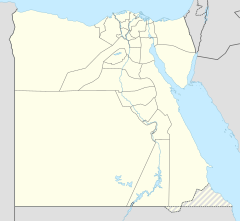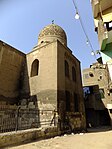Funerary complex of Sultan Qaytbay
| Funerary complex of Sultan al-Ashraf Qaytbay | |
|---|---|
| Geographic coordinates | 30°02′38″N 31°16′30″E / 30.0439°N 31.2749°E |
| Architecture | |
| Type | madrasa/mosque, mausoleum, sabil, kuttab |
| Style | late Mamluk |
| Completed | 1474 |
| Specifications | |
| Dome(s) | 2 |
| Minaret(s) | 1 |
| Criteria | Cultural: (i)(v)(vi) |
| Designated | 1979 (3rd session) |
| Part of | Historic Cairo |
| Reference no. | 89-005 |
The funerary complex of Sultan Qaytbay is an architectural complex built by the
Historical background
Sultan Qaytbay and his reign

Nonetheless, Qaytbay is known as an effective ruler who brought long-term stability while in power. He is notable as one of the greatest patrons of architecture in the Mamluk period, particularly of the
Construction and context

Qaytbay's funerary complex was one of his earliest architectural commissions; construction work for the complex began in 1470 and the mausoleum was completed in 1474.[2]: 275 The construction period was long by Mamluk standards; however, Qaytbay's complex was on a large scale and constituted an entire royal quarter or walled suburb in the then-lightly urbanized desert cemetery area east of Cairo – now known as the Northern Cemetery.[2]: 275
This desert area was developed by the Burji Mamluks in the 15th century as the main southern Qarafa necropolis, not to mention the main city itself, became too full for major new monuments. Major construction projects like Qaytbay's may have been aimed in part at urbanizing this spacious area at the time, though eventually it became mostly an extension of the city's vast cemeteries.[5] Its religious and commercial establishments took advantage of a caravan route which ran through it from Cairo to Mecca in the east and to Syria in the north.[1]: 233
Qaytbay's large complex, like others built by Mamluk
: 275- 19th-century images of the complex
-
Illustration of the Qaytbay complex by David Roberts (c. 1848)
-
Exterior of the Qaytbay complex (c. 1867)
-
Photo of the mosque's interior (c. 1867)
-
Photo of the mosque's mihrab and minbar (c. 1867)
-
Photo of Qaytbay's tomb chamber (c. 1867)
Description
Overview

Qaytbay's complex contained numerous buildings over a relatively vast area, enclosed by the same wall, of which one gate, Bab al-Gindi, still remains to the south of the mausoleum.[1]: 246 Many of the original structures which once faced each other on both sides of the existing street have vanished.[2]: 275 What remains today is the mosque, which is attached to the mausoleum of Qaytbay himself, as well as a maq'ad (loggia), a smaller mosque and mausoleum for Qaytbay's sons, a hod (drinking trough for animals), and a rab' (an apartment complex where tenants paid rent). At one point it was also described to have had large gardens.[2]: 275
The mosque/madrasa
The mosque (originally a madrasa), along with the mausoleum of the sultan, forms the main building of the complex and is considered exceptional for its refined proportions and the subdued yet exquisite decorations. with open arches on two sides.
Inside, the vestibule features another ornate
- The mosque/madrasa
-
View of the entrance façade of the mosque/madrasa, with thesabil on the lower left and the kuttabon the upper left above it
-
The entrance portal
-
Details of the minaret
-
The western iwan
-
The wooden lantern ceiling over the prayer hall of the mosque
The mausoleum and dome
Qaytbay's mausoleum projects from the eastern side of the building, which makes the dome more visible from the street and allows for more light to reach the interior through the northern-facing windows. The outer dome of the mausoleum demonstrates an evolution from the stone domes built earlier and nearby by Sultan
On the inside, the mausoleum chamber is reached from a door next to the qibla wall. It is decorated with a carved and
- The mausoleum
-
The dome of the mausoleum
-
Closeup of the dome's stone-carved relief patterns
-
The mausoleum chamber of Sultan Qaytbay, with mihrab visible (photo from 2006, before recent restorations)
-
Interior of the mausoleum dome
Auxiliary structures
To the west of Qaytbay's main mosque is a smaller domed tomb which may have been built earlier when Qaytbay was only an
Just to the north of the mosque, on the main street, is a hod or drinking trough for animals, with shallow decorative niches along its wall.[1]: 244 Further north are the semi-ruined remains of a rab' or apartment complex on the west side of the main street. It is partially buried below street level but its high vaulted entrance portal is still visible.[2]: 276
- Auxiliary structures of the complex
-
The remains of the old gate of Qaytbay's complex, Bab al-Gindi
-
The smaller attached mausoleum, dedicated to Qaytbay's son and, later, to Gulshani
-
The (recently restored) maq'ad of Qaytbay's complex, a part of the residential compound he built
-
The hod of Qaytbay complex, a drinking trough for animals (pictured in 2012, before recent restoration)
-
Stone-carved details of the hod
-
The remains of the rab' or apartment bloc of Qaytbay's complex, north of the mosque
-
Portal of the rab' of Qaytbay's complex
Modern-day use and restoration
For the past few years, the Cairo-based ARCHiNOS Architecture has been conserving monuments within the funerary complex of Sultan al-Ashraf Qaitbey. The work is primarily financed by the European Union and done under the auspices of the Historic Cairo Project within the Egyptian Ministry of Antiquities. ARCHiNOS has increasingly included social development and cultural components in its work, and has adapted the reception hall in the Sultan's onetime residence (maq‘ad) for a hub of art and culture in the neighbourhood. ARCHiNOS also upgraded the small urban square in front of the building to make it a fitting setting for various cultural events organised in and around the maq‘ad of Sultan Qaitbey. In 2016, the not-for-profit Sultan Foundation has been established to provide access to culture in the underprivileged neighbourhood and to promote links between preservation of cultural heritage and social and economic development.[10][11][12]
See also
- Khanqah-Mausoleum of Sultan Barsbay
- Mosque of Qaytbay (Qal'at al-Kabsh)
- Lists of mosques
- List of mosques in Africa
- List of mosques in Egypt
References
- ^ a b c d e f g h i j k l m n o Williams, Caroline. 2008 (6th ed.). Islamic Monuments in Cairo: The Practical Guide. Cairo: American University in Cairo Press.
- ^ a b c d e f g h i j k l m n o p q Behrens-Abouseif, Doris. 2007. Cairo of the Mamluks: A History of Architecture and its Culture. Cairo: The American University in Cairo Press.
- ^ a b AlSayyad, Nezar. 2011. Cairo: Histories of a City. The Belknap Press of Harvard University Press.
- ISBN 978-0-674-00316-3.
- ^ El Kadi, Galila; Bonnamy, Alain (2007). Architecture for the Dead: Cairo's Medieval Necropolis. Cairo: The American University in Cairo Press.
- ^ a b Discover Islamic Art (entry on "Madrasa and Mosque of Sultan Qaytbay"), retrieved on January 25, 2014, http://www.discoverislamicart.org/database_item.php?id=monument;ISL;eg;Mon01;12;en
- ^ O'Neill, Zora et al. 2012 (11th edition). Lonely Planet: Egypt. Lonely Planet Publications.
- ISBN 9781108483841.
- ^ Williams, Caroline (2018). Islamic Monuments in Cairo: The Practical Guide (7th ed.). Cairo: The American University in Cairo Press.
- ^ "ARCHiNOS – Heritage Preservation, Cairo, Egypt". Retrieved 2024-01-28.
- ^ "Culture Heritage for the Living in the City of the Dead". European External Action Service. Retrieved 2024-01-28.
- ^ Tewfik, Nourhan (21 February 2016). "'Artists must play a role in beautifying the city:' Cairo's City of the Dead infused with culture". Ahram Online. Retrieved 28 January 2024.
External links
- 3D Virtual Tours - spherical view of the interior of Qaytbay's mosque.
- 3D Virtual Tours - spherical view of the interior of Qaytbay's tomb chamber.
- Discover Islamic Art - information and pictures on Qaytbay's mosque/madrasa, including floor plan.
- Dobrowolska Agnieszka/Dobrowolski, Jaroslaw: More than Stones: Heritage for the Living in Cairo's 'City of the Dead', 2018


























